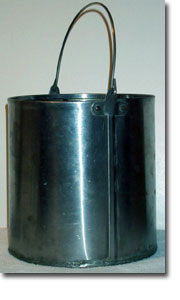Although
the exact etymology of the word growler, is a little unclear, it's 19th century
to current history is interesting. Growlers or half gallon glass jugs are
popular with local microbreweries as a way to sell 'take home' beer. Back in
the 19th century parents would at dinnertime send their child to a local bar or
brewery to fetch beer in a pail, or covered bucket, which was referred to as a
"growler."
Brander
Matthews wrote about it in Harper's Magazine in July 1893: "In New York a can
brought in filled with beer at a bar-room is called a growler, and the act of
sending this can from the private house to the public-house and back is called
working the growler".
It was
also called rushing the growler, since perhaps these children were often in a
hurry. Teenagers could make good money and get a free lunch if they would show
up at the factories and pick up the workers' beer pails to get them filled  at
the taverns. They would sometime use a long pole in order to carry a quantity
of pails to refill on one trip. Another possible explanation for using the term
'rushing' the growler.
at
the taverns. They would sometime use a long pole in order to carry a quantity
of pails to refill on one trip. Another possible explanation for using the term
'rushing' the growler.
Regarding
the term 'growler the Trenton Times for 20 June 1883 said, perhaps in jest "It
is called the growler because it provokes so much trouble in the scramble after
beer"
One can
only imagine that if you spilt your fathers can of Ale that he was the growler.
It seems that it may have been a slang term, and those who "rushed the growler"
were no doubt the poorer working class looked down upon by the upper crust of
society.
It reminds me of the part in John Barleycorn where he says "It was on a hot day, and my father was ploughing in the field. I was sent from the house, half a mile away, to carry to him a pail of beer".